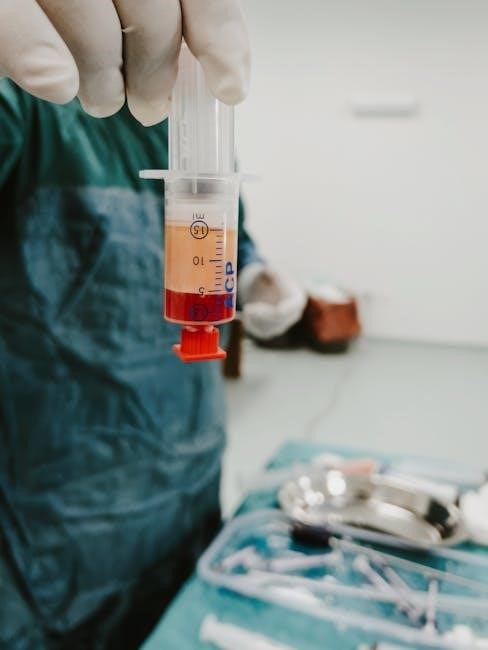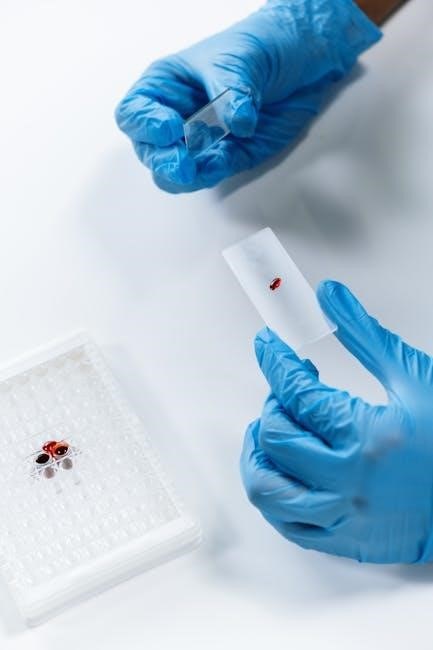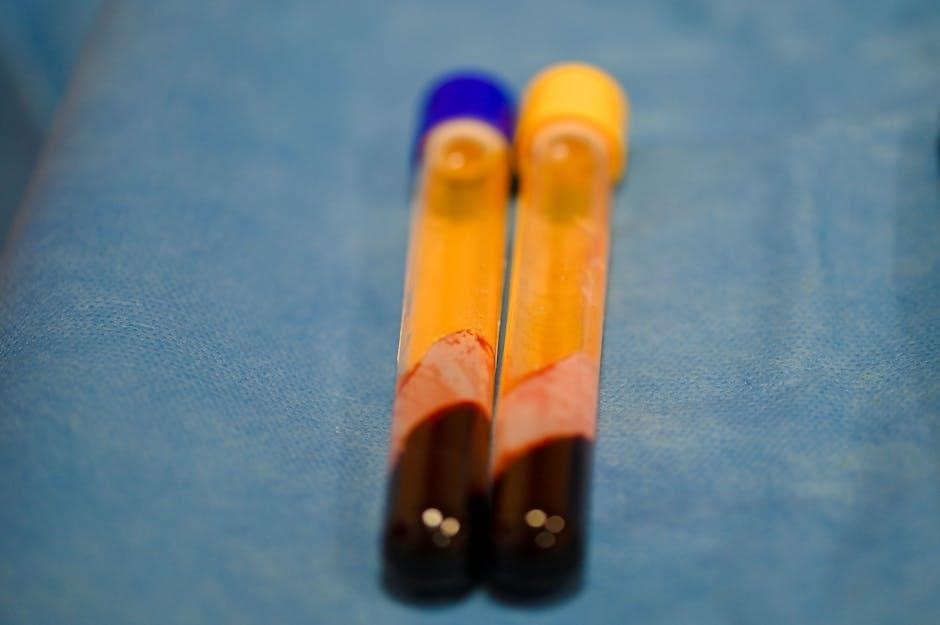A pathology report is a detailed document summarizing the examination of tissue or fluid samples. It provides critical diagnostic information, guiding treatment decisions and patient care.
1.1 What is a Pathology Report?
A pathology report is a detailed document created by a pathologist after examining a tissue or fluid sample. It includes the patient’s and specimen’s identification, clinical history, and diagnostic findings. The report provides a microscopic and macroscopic analysis, final diagnosis, and recommended next steps. Pathologists use biopsies, surgeries, or other procedures to obtain samples, ensuring accurate diagnoses. This report is crucial for guiding treatment plans and understanding the patient’s condition comprehensively.
1.2 Importance of Pathology Reports in Diagnosis
Pathology reports are vital for accurate diagnosis, as they provide detailed insights into tissue and cellular abnormalities. They help identify diseases, such as cancer, by describing the type and severity of abnormal cells. This information is essential for developing targeted treatment plans, ensuring precise patient care. Pathology reports also guide prognostic outcomes and inform follow-up monitoring, making them a cornerstone in clinical decision-making and patient management.

Structure of a Pathology Report
A pathology report is organized into sections, including patient/specimen info, clinical history, gross description, microscopic findings, and final diagnosis with the pathologist’s signature.
2.1 Patient and Specimen Information
This section includes the patient’s name, date of birth, and medical record number. It also details the specimen type, collection date, and location on the body. Accurate identification ensures proper diagnosis and treatment.
2.2 Clinical History and Pre-operative Diagnosis
This section provides the patient’s medical history, symptoms, and pre-operative diagnosis. It includes the suspected condition and relevant clinical context. The clinical history helps the pathologist interpret findings accurately, while the pre-operative diagnosis guides the examination. This information is crucial for correlating pathological findings with the patient’s clinical presentation, ensuring precise diagnosis and appropriate treatment planning.
2.3 Gross Description of the Specimen
The gross description details the macroscopic appearance of the specimen. It includes size, shape, color, and any notable features. This section helps visualize the specimen, providing context for microscopic findings. Information like tumor location and appearance is recorded, aiding in accurate diagnosis. The gross description is a fundamental step in pathology reporting, offering a clear picture of the specimen’s characteristics before further examination. This helps guide additional testing and ensures comprehensive analysis.
2.4 Microscopic Examination Findings
Microscopic examination findings reveal cellular details observed under a microscope. Pathologists analyze cell structures, patterns, and abnormalities. This section identifies features such as tumor type, grade, and invasion depth. Special stains or tests may be noted to highlight specific characteristics. The findings are crucial for diagnosis, prognosis, and treatment planning. They provide detailed insights into the specimen’s cellular makeup, ensuring accurate and informed clinical decisions. This section is vital for understanding the biological behavior of the examined tissue.
2.5 Final Diagnosis and Pathologist’s Signature
The final diagnosis summarizes the pathologist’s conclusions based on microscopic, gross, and clinical findings. It provides a clear and concise statement of the disease or condition. The pathologist’s signature authenticates the report, ensuring accountability for the accuracy of the diagnosis. This section is critical for guiding clinical decisions and treatment plans. The signature confirms the pathologist’s professional oversight and validation of the findings, making it a legally binding document in patient care and management.

Types of Pathology Reports
Pathology reports include surgical, cytology, and hematopathology reports, each detailing specific examinations and findings. These documents guide diagnosis and treatment decisions with precise clinical information.
3.1 Surgical Pathology Report
A surgical pathology report details the examination of tissue removed during surgery. It includes patient and specimen information, pre-operative diagnosis, gross description, microscopic findings, and final diagnosis. The report guides treatment decisions, confirming the presence and type of disease. Special tests like immunohistochemistry or molecular analysis may be included. The pathologist’s signature verifies the findings, ensuring accurate and reliable results for clinical management. This report is critical for diagnosing conditions like cancer, infections, or inflammatory diseases.
3.2 Cytology Report
A cytology report examines cells from bodily fluids or tissues to detect abnormalities. Common tests include Pap smears and fine-needle aspirations (FNA). The report details patient and specimen information, clinical history, and microscopic findings. It categorizes results as benign, malignant, or inconclusive. Special tests like immunohistochemistry may be included. Cytology reports are crucial for diagnosing cancers, infections, or inflammatory conditions, aiding in early detection and treatment planning. They provide vital insights for clinicians to manage patient care effectively.
3.2 Hematopathology Report
A hematopathology report focuses on diagnosing blood-related disorders, such as anemia, leukemia, or lymphoma. It includes patient and specimen details, clinical history, and lab findings from blood or bone marrow samples. The report outlines cell morphology, genetic abnormalities, and special tests like flow cytometry or molecular studies. It provides a comprehensive diagnosis, guiding treatment for hematologic conditions. Hematopathology reports are essential for accurate detection and management of blood diseases, ensuring personalized patient care and therapeutic interventions.

Special Tests and Additions
Special tests in pathology reports include immunohistochemistry, molecular testing, and genetic analysis. These provide detailed information on tissue markers, genetic mutations, and cancer staging, aiding precise diagnosis and treatment planning.
4.1 Immunohistochemistry Results
Immunohistochemistry (IHC) results identify specific protein markers in tissue samples, aiding in precise diagnosis and treatment planning. These markers help classify tumors, determine cancer subtypes, and predict response to therapies. For example, IHC can detect hormone receptor status in breast cancer or PD-L1 expression for immunotherapy guidance. The results are presented as positive, negative, or equivocal, with interpretation critical for targeted treatment strategies. This section is essential for oncologists to tailor personalized therapies based on molecular characteristics of the tumor.
4.2 Molecular Testing and Genetic Analysis
Molecular testing and genetic analysis provide detailed insights into genetic mutations and alterations within tissue samples. Techniques like PCR, FISH, or next-generation sequencing identify specific biomarkers, such as EGFR mutations in lung cancer or BRCA mutations in breast cancer. These findings guide targeted therapies by identifying actionable mutations. The report includes mutation status, variant classification, and clinical significance, enabling personalized treatment plans. This section is crucial for modern oncology, offering precise therapeutic options based on genetic information.
4;3 TNM Staging and Cancer Grading
TNM staging categorizes cancer based on tumor size (T), lymph node involvement (N), and metastasis (M). It provides a standardized system to describe cancer extent, aiding prognosis and treatment planning. Cancer grading assesses tumor cell abnormality, with higher grades indicating more aggressive tumors. For example, Gleason scores for prostate cancer or tumor grades (G1-G3) are common. These classifications help determine disease severity and guide therapeutic strategies, ensuring personalized patient care and accurate prognostication.

Sample Pathology Report PDF
A sample pathology report PDF provides a template for understanding the structure and content of real reports. It includes sections for patient/specimen details, diagnoses, and test results.
5.1 How to Download a Sample Pathology Report
To download a sample pathology report, visit websites like Roswell Park Cancer Institute or other medical institutions. Navigate to their pathology section, select the sample report, and choose the PDF format. Ensure compatibility with your device. These samples provide a clear template for understanding real reports. Such reports typically include patient/specimen details, diagnoses, and test results, offering a comprehensive example for educational purposes.

5.2 Key Features of a Sample Pathology Report
A sample pathology report includes patient and specimen identification, pre-operative and final diagnoses, gross descriptions, microscopic findings, and additional test results. It also features the pathologist’s signature and institutional details. These elements ensure clarity and accuracy, making it a valuable resource for understanding real-world pathology documents. The report structure is standardized, providing a consistent format for healthcare professionals to review and interpret findings effectively.

Understanding the Report
Understanding a pathology report involves interpreting detailed descriptions of tissue samples, medical terminology, and standardized elements to grasp the diagnostic findings accurately.
6.1 Interpreting the Pathologist’s Findings
Interpreting the pathologist’s findings requires understanding the detailed observations and conclusions based on tissue or fluid analysis. The report includes descriptions of abnormalities, such as cancer, infections, or inflammation. Key elements like tumor type, grade, and stage are crucial for determining prognosis and treatment. Special tests, such as immunohistochemistry or molecular studies, provide additional insights. The final diagnosis summarizes the findings, guiding clinical decisions. Patients should discuss the report with their healthcare provider to understand its implications and next steps in care.
6.2 Common Terminology Used in Pathology Reports
Pathology reports use specific terminology to describe findings accurately. Terms like “benign” or “malignant” indicate whether a lesion is non-cancerous or cancerous. “Metastasis” refers to cancer spread, while “tumor grade” describes its aggressiveness. “TNM staging” defines cancer extent, and “Gleason score” is used for prostate cancer. Terms like “immunohistochemistry” or “HbA1c” refer to specialized tests. Understanding these terms helps patients and clinicians interpret the report’s significance and implications for treatment.

Clinical Implications and Next Steps
The pathology report’s findings guide treatment decisions, such as surgery, radiation, or surveillance. Follow-up care, including tests like bone scans, ensures monitoring and optimal patient outcomes.
7.1 Treatment Options Based on Pathology Results
Pathology results dictate treatment plans, such as surgery, radiation, or active surveillance. For cancer cases, options may include chemotherapy or targeted therapy. The report’s findings, like tumor stage and grade, help determine the most effective approach. Additionally, molecular testing results can guide precision medicine strategies. Patients may also require follow-up tests, such as bone scans, to monitor disease progression and adjust treatments accordingly. This tailored approach ensures personalized and effective patient care based on diagnostic insights.
7.2 Follow-Up Care and Monitoring
Follow-up care is tailored based on pathology results, ensuring comprehensive monitoring. Patients may require scheduled imaging scans, blood tests, or periodic check-ups. The report often outlines recommended timelines for follow-ups, such as bone scans or repeat biopsies. Monitoring plans are designed to detect early signs of recurrence or disease progression. This proactive approach helps manage health effectively, ensuring timely interventions and improving long-term outcomes for patients. Regular monitoring also helps track treatment efficacy and adjust care plans as needed.
A pathology report is a vital tool in diagnosis and treatment planning. It provides a detailed analysis of tissue samples, guiding healthcare decisions and patient care effectively.
8.1 Summary of the Pathology Report’s Role in Patient Care
A pathology report is essential for accurate diagnosis and treatment planning. It provides detailed analysis of tissue samples, including findings from microscopic exams, immunohistochemistry, and molecular tests. This information helps healthcare providers understand the nature of a disease, guiding tailored therapies and patient monitoring. The report also serves as a reference for future care, ensuring continuity and precision in medical decision-making. Its role is central to delivering effective, personalized patient care.
